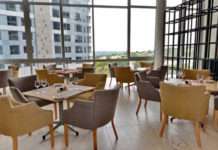- For more than 400 years, communities in the Guassa grasslands of Ethiopia’s central highlands have practiced a sustainable system for managing the area’s natural resources.
- The system’s robustness was severely tested from 2020 with the one-two punch of COVID-19 and the Tigray war, but held strong.
- Threats to the grassland persist, however, from a growing population and road projects, which the community hopes to address through ecotourism initiatives as an alternative source of income.
- The Guassa Community Conservation Area is home to rare plant and wildlife species such as gelada baboons, Ethiopian wolves, and the versatile guassa grass that’s a central part of community life.
GUASSA COMMUNITY CONSERVATION AREA, Ethiopia — On an early misty morning in July, Worku Mekonen, 39, one of the scouts at the Guassa Community Conservation Area in Ethiopia’s central highlands, arrives at his duty site and starts patrolling.
Walking deep into the shrubland covered in lush green grass, everywhere he turns, Mekonen happily recounts the positive impacts of the community’s conservation efforts. While shrubs and flowers add bursts of lively colors to the landscape, almost every other vegetation has turned green after a bout of rain, giving the area a refreshing and rejuvenating aura.
From a distance, a herd of gelada monkeys (Theropithecus gelada) enjoy the morning sun as they graze on the fresh grass that’s grown back.
With Afro-alpine grasslands covering 11,000 hectares (27,000 acres) of land, an area larger than the city of Paris, sitting at an altitude nearly the height of Mount Fuji, Guassa is renowned as one of the oldest unbroken examples of Indigenous resource management in Africa.
However, the dual impacts of the ravaging Tigray war and the COVID-19 pandemic introduced a new set of challenges to the community, bringing battles to their doorstep and shattering their burgeoning ecotourism industry. Now, through community-led efforts and sustainable resource use, the conservation area is being revived once again, and looks set to thrive, say community leaders and zoologists.
“I feel a sense of pride and satisfaction when I see the progress we’ve made. Everything looks well-managed,” Mekonen says.
Behind him, community volunteers work diligently on constructing a new tourist lodge, a project that aims to further support the area’s ecotourism initiatives.
For more than 400 years, the grasslands in the Guassa area of Menz in Ethiopia’s central highlands were governed under a communal management system known as qero. In this system, elected headmen with a historic right over the natural resources determined when and for how long locals could harvest thatch grass and graze their livestock. In 2003, most of Guassa formally became a protected area.
As the local communities protect this reserve mainly for its vast plains of guassa or festuca grass (Festuca spp.), the wildlife benefit directly from it. The grass is an important resource for people, who have harvested it sustainably for centuries in rotation systems. It’s a versatile resource that can be used for roof thatch, rope, construction material, weaving and clothing fabric, livestock fodder, and fuel.


By regulating the exploitation of the area, the qero system has successfully protected the unique and diverse alpine flora and the rare endemic fauna of the area, including 22 mammal species. Among these is the most endangered carnivore in Africa, the Ethiopian wolf (Canis simensis), and the endemic gelada baboon. The wolf thrives in the area as the rodents that constitute its main prey abound in the regularly cut grassland habitat.
Community leaders also introduced a contemporary feature to the traditional system: an ecotourism project to serve as an additional source of income for locals and tackle the illegal cutting of guassa grass.
With population growth and lack of economic opportunities, cutting and selling the grass became a means for families to get needed cash. Jobs in the Guassa Community Lodge and its tourism revenue played a great role in providing direct economic benefits from conservation and financed community projects, according to Demis Mamo, the manager of the tourism lodge.
“We witnessed that illegal practices declined because of the economic opportunities which the ecotourism creates,” he tells Mongabay.
However, the coronavirus pandemic and subsequent lockdowns, which engulfed almost all countries around the world, dealt a significant blow to tourism. Ecotourism, which had been a promising source of income, came to a grinding halt.
“As tourist flow decreased due to the pandemic, ecotourism activities were totally closed,” says Admassu Getaneh, chief warden at the Menz-Guassa Community Conservation Office, a government body that provides technical support for community conservation. “Some community members were trying to illegally mow the guassa grass to [sell and] get some cash.”

But due to the community’s governance systems and enduring cultural traditions, these practices were halted by local leaders before they could escalate and degrade the natural resources of the area, Getaneh tells Mongabay. The patches of cut grass quickly grew back within just six months.
Yet even as the impacts of COVID-19 continued to be felt, another threat soon emerged: the Tigray war.
The war broke out in November 2020, pitting the Ethiopian federal government and neighboring against the Tigray People’s Liberation Front (TPLF) over conflicts of governance and political power. The fighting resulted in widespread displacement, war crimes and murder, and the deaths of 600,000 civilians. While initially centered in the Tigray region, the TPLF forces expanded their offensive into the neighboring Amhara and Afar regions, intensifying the conflict. Some members of the local community served alongside federal troops and, for a period, Guassa was a battlefront. The official number of locals killed in the war have not been made public.
According to Desta Dankalem, one of the nine board members of the community, as the fighting drew closer to the conservation area, the Menz-Guassa community grew increasingly concerned about the fate of their protected site.
“During that time, we as a community discussed ways to prevent the war’s impact on the conservation area and reminded neighboring communities to always consider the well-being of our protected site in every move,” Dankalem says. “We knew that the conflict would come to an end someday, and when that time comes, we should not have to face a long-lasting problem due to damage to our environment, which is everything.”

On Nov. 2, 2022, the warring sides signed a peace treaty, committing to a permanent cessation of hostilities.
The conflict didn’t cause as much damage to Menz-Guassa as feared. However, some parts of the conservation area, more than 1,000 hectares (nearly 2,500 acres) of grassland, were burned in November 2021 during battles between local militias and the TPLF. Though this was the most severe damage the conservation area had seen in 40 years, there were no long-term impacts to the grasslands, the rodents, or the wolves roaming the area.
“Some community members tried to control the fire, risking their lives in the middle of a fire exchange,” Dankalem says. “The grass has a strong connection with our life, it is our everything.”
The war also brought damage to the Guassa Community Lodge and local properties. Windows and doors were broken, items were displaced and furniture, electricity generators and kitchen appliances were stolen. Most locals blame the TPLF fighters who controlled the area. But as law and order loosened, local people also became involved in the looting.
When the fighting ended, all members of the community worked to repair the damage, recover the looted items, rebuild houses and clean up the war debris. Now, the old community lodge is open for tourists again, and the community is working on the construction of a new lodge, about 5 kilometers (3 miles) from the old one.
“We foresee no major issues in restoring the system in place,” Getaneh says. “We take pride in our ability to maintain and sustain our environment even in such difficult times where most systems collapse and take longer to reconstruct.”


The new lodge will provide much-needed income for the community and may attract more money than the old one as it’s closer to a nearby town, Getaneh tells Mongabay. It will have traditional guest rooms, bedrooms, kitchen and a mixed-use hall, for staging performances and other events.
“The construction took almost two months,” Getaneh says. “Now, it won’t take more than a month to finalize and commence operation.”
Despite the positive developments in overcoming the challenges posed by first the pandemic and then the war, the conservation site continues to come under pressure.
“As population increases, there are tendencies to illegally farm the buffer areas of the conservation area,” Getaneh says. He adds this is why revenue from the tourism sector is important. Although, community leaders always underline the illegality of such actions to farmers and consult with them, the way to tackle the root of the problem is to generate additional income through activities such as tour guiding, horse rentals, cooking and other tourism jobs, Getaneh tells Mongabay.
The construction of new roads, passing through the conservation area’s boundaries, also poses a challenge to the conservation area. One of the two roads under construction will run 55 km (34 mi) and connect the nearby town Mehal Maha to the town of Ataye.
While road access has benefits for the local community, including giving residents better access to health care, markets and tourists, it also brings great challenges to the ecosystem, Getaneh says.
“The road construction has posed major challenges to the biodiversity of the area,” says Getacher Mengesha, wildlife tourism expert at the Menz-Guassa Community Conservation Office. The construction of both roads is causing habitat loss, fragmenting wildlife corridors that animals like wolves use to roam, and degrading and damaging the guassa grassland.
The government has paid compensation for the damage, totaling 47 million birr (about $860,000). According to Getaneh, that amount falls short of the ecological value of the land lost, but he says the community will use the money to strengthen conservation projects, like the nursery where they grow seedlings of indigenous plants like African juniper (Juniperus procera).
Zelalem Tefera, an Ethiopian zoologist and environmentalist who has studied the cultural traditions of the conservation area, says the community’s steadfast commitment to sustainable resource use and community-led conservation efforts has proved effective in building greater ecological resilience to future challenges.

Tefera has dedicated his life to studying the Ethiopian wolf and promoting sustainable natural resource management practices throughout the country. He laments the significant challenges the community faced due to COVID-19 and the Tigray war. Yet despite these setbacks, Tefera says, the community-based approach to conservation holds great promise.
“When local communities have ownership over their natural resources and derive tangible benefits from them through Indigenous knowledge and practices, it definitely can persist even in times of hardship,” he tells Mongabay.
According to Tefera, government conservation officials have informally proposed turning Guassa into a national park — a move that would result in the community being evicted. Resource use would also be prohibited, which would bar community access to guassa grass and potentially trigger conflicts, drive up rates of poverty, engender negative attitudes toward the park, and result in the collapse of the traditional resource management system, Tefera says.
He says successful conservation outcomes require a deep understanding of both the ecological dynamics of a given area and the ways of life of the people who live there, as seen in Guassa.
“We must move beyond overreliance on traditional conservation models that prioritize establishment of national parks,” Tefera tells Mongabay. “Instead, we should integrate local knowledge and expertise into our conservation strategies, forging robust partnerships with communities across our diverse landscapes.”
Banner image: Desta Melaku, one of the board member of Guassa Community Conservation Office, stands in front of a field of guassa grass. Image by Solomon Yimer for Mongabay.
As Ethiopia’s war rages, a 400-year-old conservation site is scarred by battle
Related listening from Mongabay’s podcast: We speak with National Geographic photographer Kiliii Yuyan to talk about the value of traditional ecological knowledge (TEK) in protecting the world’s biodiversity and examples of TEK from Indigenous communities he’s visited. Listen here:
FEEDBACK: Use this form to send a message to the author of this post. If you want to post a public comment, you can do that at the bottom of the page.
This story first appeared on Mongabay
South Africa Today – Environment
This article is licensed under a Creative Commons Attribution-NoDerivatives 4.0 International License.
You may republish this article, so long as you credit the authors and Mongabay, and do not change the text. Please include a link back to the original article.












